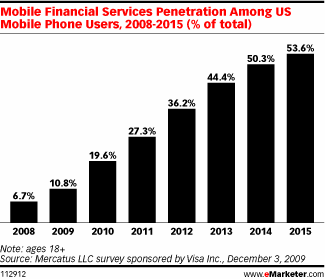Since 2008, consumers have been moving from brick-and-mortar banking to online banking at an impressive rate. This trend is welcomed not only by consumers who like the convenience of anytime banking, but also by financial institutions that like to streamline operations and cut down costs.
Several forecasts predict that by 2015, 50% or more of US mobile users will be conducting transactions from their mobile devices (e.g. opening an online savings account).

There are many critics that point out that will not happen. According to a survey commissioned by identity protection services firm Kindsight, nearly two-thirds of respondents worried that banking, credit card or other personal info could be stolen from their computers. Bloomberg Businessweek joins the pack of critics with a July 2010 report claiming that “Gen Y lacks confidence about making financial decisions”. As an example, Bloomberg Businessweek cites that fewer than 4,000 Facebook users have clicked the “like” button for Fidelity’s Page and about 9,000 have done so for Vanguard’s. Meanwhile 4.2 million people say they like Apple iTunes on Facebook. As another example, Schwab, which began sending Twitter feeds in mid-June 2010, has 277 followers. The WholeFoods Twitter account has 1.8 million followers.
What Bloomberg Businessweek and other critics fail to understand is that social media activity is not a proper way to measure whether members of Generation X and Y are accessing their bank accounts mostly online. You need to look at the bigger picture, which is formed mainly by 2 factors: 1) preferred banking method of Generation X and Generation Y, and 2) activities least likely to give up for a week by Generation X and Y.
